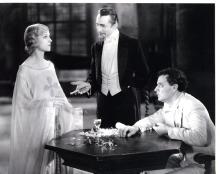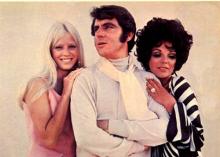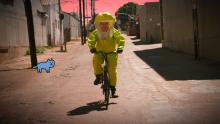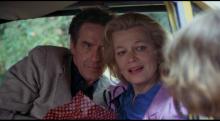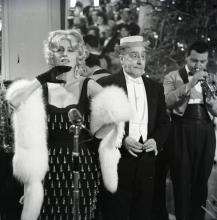This essay on Richard Attenborough's Oh! What a Lovely War was written by Cinematheque Programmer Amanda McQueen. The conclusion of our Musicals of 1969 series, Oh! What a Lovely War will screen on Friday, February 12, at 7 p.m. in the Cinematheque's main venue, 4070 Vilas Hall.
By Amanda McQueen
Fabulous, shrewd, mocking, emotional, witty, technically brilliant: these are just some of the adjectives Variety used to describe Oh! What a Lovely War. But Variety also anticipated that this musical recounting the events of World War I could be a hard sell. Indeed, as director Richard Attenborough explained, it was a “courageous move” by Paramount to fund the film in the first place; it was anti-war, it was exceedingly British in subject and tone, and its style was unorthodox. But what it lacked in commercial potential, it made up for in artistic promise. Hailed as a “masterpiece,” Lovely War is a moving and beautiful example of the unusual approach to film musical production that makes the late-1960s such a fascinating period of the genre’s history.
Lovely War began in 1962 as The Long Long Trail, a BBC radio play that critiqued WWI through a combination of facts, reminiscences, and contemporary popular songs—including the soldiers’ alternate versions of those songs, written in the trenches and recorded in the 1917 collection Tommy's Tunes (e.g. “What a Friend We Have in Jesus” became “When This Lousy War is Over”). The broadcast was adapted for the stage in March 1963 by Joan Littlewood, director of the alternative Theatre Workshop in London's East End. Littlewood presented Oh, What a Lovely War! as a commedia dell'arte-style revue, in which actors, dressed in Pierrot costumes, improvised against a backdrop of period photographs and a neon ticker-tape running statistics. In June—despite objections from the family of Field-Marshal Sir Douglas Haig—the musical transferred to the West End, where it enjoyed a long and celebrated run. Lovely War made the jump to Broadway in September, but despite four Tony nominations, it closed in January 1965 at a financial loss. Variety surmised that Broadway’s audience was “too old, too passive, and too frivolity-minded” to appreciate Littlewood's endeavor.
Two years later, John Mills brought his friend and fellow actor Richard Attenborough a screenplay for a film version of Lovely War, insisting that he direct it. Attenborough had long been considering moving into directing, but, following David Lean's advice that “the time to direct is when you feel that if you don’t direct that particular film, you’ll die,” he’d been hesitating. But Attenborough had a penchant for socially-conscious projects, and he’d seen Lovely War multiple times on stage, so he accepted Mills’ proposal.
To secure funding for the challenging project, Attenborough went directly to Charles Bludhorn, head of Paramount’s parent company, Gulf+Western, who was thought to be just nuts enough to say yes. As part of his pitch, Attenborough promised to fill a significant portion of Lovely War’s 120 speaking parts with top British actors. Bludhorn agreed: if Attenborough could supply the marquee names—chief among them Sir Laurence Olivier—Paramount would supply the money. Thanks to Attenborough’s personal connections and Lovely War’s strong reputation, the director more than delivered, and a veritable Who’s Who of British stars agreed to take small, featured roles for minimal pay. Mills, in return for initiating the project, was cast as Haig. With Paramount on board, Attenborough partnered with producer Brian Duffy and writer Len Deighton (Duffy and Deighton had purchased the film rights from Littlewood) to co-produce under the newly-formed Accord Productions.
Deighton also worked on Lovely War’s screenplay. Interestingly, though, while Variety claims Deighton as the sole author, Attenborough attributes the script to both Deighton and John Mills. Furthermore, early in 1969, for reasons that are slightly unclear, Deighton quit the film and asked that his name be removed. Nevertheless, it does seem to have been Deighton who was chiefly responsible for reshaping Littlewood’s play for the screen. He replaced the Pierrot concept with that of a seaside arcade; he created the Smiths—an archetypal British family, played by unknown actors—to provide a narrative through-line; and he turned the stage musical’s M.C. character into The Photographer (Joe Melia), who provides commentary and records the events of the war. Other conceits of the play—such as tallying deaths on a cricket scoreboard—were retained.
Principal photography began in March 1968 at Brighton Pier and the surrounding area, where the entire film was shot over a period of fourteen weeks. After shooting wrapped in September, Attenborough went to Twickenham Studios, London, to assist with editing. Going only slightly over budget, Lovely War came in around $3 million—a tiny sum compared to other late-1960s musicals. It was released in the UK in April 1969, and opened in America that October, immediately following its showing at the New York Film Festival.
Perhaps unsurprisingly, Lovely War was only a modest commercial success; it was, however, a critical favorite. Judith Crist called it not only “the best film of 1969 but an outstanding film for all time.” Roger Ebert called it “breathtaking.” It won 6 BAFTAs and the Golden Globe for Best English Language Foreign Film. The acting and the technical credits were all deservedly applauded, and the film’s final shot—16,000 white wooden crosses in a field—was universally singled out for its emotional impact. The bulk of the praise, however, went to Attenborough and his skillful blending—in Crist’s words—of “theatrical fantasy with the realism that the camera demands and creates.” Indeed, Lovely War transitions fluidly—sometimes through editing, sometimes through camera movement—from the cheerful artificiality of Brighton Pier to the devastating reality of war. It layers the symbolic over the realistic: men lie in the muddy trenches, not blown to bits, but clutching poppies. And woven throughout are dozens of optimistic, bawdy, cynical, and tragic songs, sometimes presented as lavish production numbers and sometimes presented starkly a capella.
In the late-1960s, Hollywood seemed particularly willing to gamble on artistically adventurous film musical productions. Oh! What a Lovely War proves that those gambles could pay off. Born of experimental theater and shaped by a deft and daring cinematic hand, Lovely War is nothing if not unique. It is a challenging musical—history, politics, and Britain’s class hierarchies are key to its arguments—but it is also visually striking, emotionally rich, and truly unforgettable.


